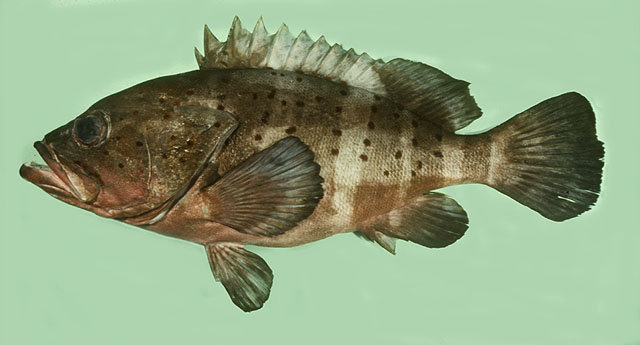| Epinephelidae (Groupers) |
| 50 cm TL (male/unsexed) |
|
reef-associated; marine; depth range 40 - 130 m |
| Western Pacific: Andaman Sea to southern Japan, Taiwan, China, Philippines, Viet Nam, Malaysia, Thailand, Indonesia, New Guinea, the Arafura Sea (Ref. 9819), northwestern Australia, and Fiji. |
|
Dorsal spines (total): 11-11; Dorsal soft rays (total): 15-16; Anal spines: 3-3; Anal soft rays: 8-8. This species is distinguished by the following characters: body depth less than head length, 2.5-3.0 times in SL; large head length 2.1-2.4 times in SL; rounded preopercle with 3-6 enlarged serrae at the angle; upper edge of operculum slightly convex; midside of lower jaw with 2 rows of teeth; gill rakers of first gill arch 8 + 14-16 = 22-24; scaly maxilla, reaching about vertical at rear edge of eye; pectoral and pelvic fin length are equal, 1.7-2.3 times in head length; ctenoid lateral body scales, few auxiliary scales in adults. Colour of head, body and median fins are pale grey; 5 broad dark brown bars, first 2 extending into the spinous part of dorsal fin, 3rd and 4th bars extending into the soft dorsal and anal fins, 5th dark bar at the base of the caudal fin; edges of dorsal parts of body bars with small black spots; nape with dark brown saddle blotch, small black spots mainly along edge of the blotch; cheeks, snout, interorbital area, jaws and chest mostly dark brown, with 2-3 white bands radiating from the eye; irregular black bar on the middle of the caudal fin; yellow maxillary groove; small juveniles (6 cm SL) white, with black bars on body as described for adults, the fins pale yellow with small black spots (Ref. 39231, 89707). |
| This species is usually found on offshore coral and rocky reefs. A popular and commercially important species in Hong Kong, but not in Singapore. Caught with hand lines and sold fresh (Ref. 39231). |
|
Least Concern (LC); Date assessed: 18 November 2016 Ref. (130435)
|
| harmless |
Source and more info: www.fishbase.org. For personal, classroom, and other internal use only. Not for publication.
